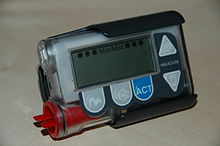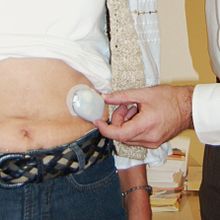Insulin pump
An insulin pump is a medical device for insulin pump therapy ( continuous subcutaneous insulin infusion , abbreviated CSII ). In the pump therapy is insulin preparation not using syringe or insulin pen, several times a day subcutaneously injected, but by a small programmable pump via a catheter passed, and an injection needle (infusion set) in the body. The pump is worn permanently on the body, but under certain conditions it can also be taken off for several hours. For this purpose, the catheter can be uncoupled from the pump and closed. Type 1 diabetics are at the forefront of this form of therapy; in rare cases, type 2 diabetics or women with gestational diabetes are also given an insulin pump.
In Germany, an estimated 55,000 diabetics carried an insulin pump in 2011, and an insulin pump register has been created here for several years. In Switzerland and Austria, 10–20% of type 1 diabetics are treated with insulin pump therapy.
Working principle
The principle is similar to that of intensified conventional (insulin) therapy (ICT) : there is a basal rate that covers the basic need for insulin, and individual boluses that are responsible for meals and value corrections. The concept is called the basic bolus principle.
In the pump there is a reservoir with only one type of insulin , either with a normal insulin or a fast-acting analog insulin. Depending on the pump model, either a small cylindrical vessel is used as the reservoir, which is itself filled with insulin with the help of a plunger (similar to a syringe), or a ready-made insulin ampoule is used, as it is used in a similar way in insulin pens. A reservoir contains between 1.5 and 3 ml of U100 (100 IU) insulin , which corresponds to 150 to 300 units of insulin.
Pump therapy is an alternative therapy to ICT insulin therapy for type 1 diabetics, as both the basal rate and the meal-related and corrective dosages can be controlled in contrast to ICT .
In ICT, an NPH insulin is injected one to three times a day, or a long-acting analogue insulin once or twice a day with an insulin pen . The basal insulin requirement is therefore difficult to calculate, as these insulins reach a peak after approx. 6–8 hours, depending on the amount of insulin applied, and then the effect flattens out again. The main action time is around 12 hours, the total duration of action depending on the delay insulin up to approx. 24 hours. An insulin pump, on the other hand, delivers the fast-acting insulin at small, even intervals (approx. Every 3 minutes) in order to achieve an even effect. You can program the basal rate per hour in the pumps and, on newer models, also per half hour. Today, pump therapy has often become a routine therapy for type 1 diabetes.
The setting and adjustment of an insulin pump takes place on an inpatient basis in a “pump center” of a hospital or on an outpatient basis in a diabetological practice. This also includes the training of the patient on the respective pump model in the operation as well as the determination and setting of the individual basal rate, the bolus calculation, handling of technical problems, pump breaks e.g. B. in sports and others.
Possibilities and limitations
The insulin pump cannot replace the function of the healthy pancreas because it cannot independently determine the blood sugar level in the adipose tissue surrounding it. There are models with an integrated blood sugar measuring system, which, however, cannot automatically determine the amount of insulin to be delivered. Nevertheless, many diabetics can live almost like healthy people with a pump, only that they still have to check their blood sugar several times a day and here too the insulin effect depends on many external factors (such as exercise).
The aim of the research is a closed loop ( English closed-loop system , including artificial pancreas called) in which a continuously measuring glucose sensor automatically measures the glucose content in the blood and in accordance with a control algorithm delivers insulin to the body. For a study carried out in 2010, an insulin pump was developed which, in addition to the insulin ampoule, also contained a glucagon ampoule. With a constant glucose measurement in the closed-loop system, glucagon was delivered via the pump if there was a risk of hypoglycaemia . This resulted in even fewer and shorter-lasting hypoglycaemias .
There are some indications in which pump therapy offers advantages over conventional therapy. These include, for example, the dawn phenomenon , in which the liver releases increased glucose into the bloodstream from around 4 a.m. and the diabetic wakes up with high values that last longer than the breakfast phase. Here, the basal rate can be increased by automatic programming during sleep, which leads to significantly better blood glucose levels when you wake up.
In systematic reviews that compared conventional insulin therapy with therapy using an insulin pump in type 1 diabetics, the patients with pump therapy showed a statistically significantly better HbA1c value of 0.3%. Concerning. There were no significant differences in the occurrence of mild hypoglycaemia, whereas severe hypoglycaemia occurred less often.
A large European study with 9814 participants shows that children and adolescents with type 1 diabetes in particular can benefit from insulin pump therapy. The pump users had less severe hypoglycaemia (9.55 vs. 13.97 per 100 patients / year), fewer hyperglycaemia with unconsciousness (2.30 vs. 2.96 per 100 / year) and slightly improved HbA1c values. In addition, pump patients required less insulin overall.
In a Health Technology Assessment (HTA) from England, the additional costs for technology and catheter material per year were estimated at £ 1,000–1400 (€ 1,160–1640). The studies showed some advantages of insulin pump therapy for both children and adults with type 1 diabetes mellitus, but not for type 2 diabetes mellitus or when used during pregnancy. Overall, insulin pump therapy has been shown to be cost effective.
Pump functions
Today's insulin pumps offer the following functions:
- Multi-basal rate programming: Adjustment of the basal rate to the different physiological insulin requirements during the day and night
- Basal rate profiles: programming of different basal rates to the physiological range, e.g. B. with regular sports activities, on working days and weekends, shift work or long-distance travel can be different
- Bolus options: delivery of an insulin bolus at different speeds before or during a meal, taking into account the glycemic index of the food
- Bolus calculator: calculates the individually necessary insulin dose on the basis of the current blood glucose value, the target value, the day-dependent insulin sensitivity and the calculated amount of insulin that is still effective.
Some insulin pumps offer:
- Interfaces : via radio or Bluetooth for communication with a blood glucose meter, remote control or personal computer
- Remote control: set the bolus delivery without having to remove the pump from its holder
- Sensor-assisted pump therapy (SuP): In communication with a continuously measuring sensor (CGM), the pump stops the insulin supply for a certain time if the value is too low. Studies are currently investigating whether this will reduce the frequency of hypoglycaemia.
The following is still under development:
- Artificial pancreas (closed -loop system ): A control algorithm constantly receives the tissue sugar values via a continuously measuring glucose sensor (CGM) and automatically regulates the insulin supply via the pump.
Patch pumps
A variant of the conventional pump with infusion set are so-called patch pumps , in which the actual pump is combined with the infusion set in a housing (so-called pod ). This unit is glued to the skin and completely replaced after two to three days. It is controlled by a separate unit connected to the pod via radio (so-called Personal Diabetes Manager - PDM ). Patch pumps were introduced in the USA around 2007 and have also been available in Europe since mid-2010. The disadvantages of this type of pump are that it can only be equipped with a single type of needle (both needle material and needle length are predetermined and cannot be varied as required), that the pump protrudes uncomfortably depending on its seat on the body and that if problems arise, not just one Catheter with needle, but the complete pump must be replaced.
Infusion set
An infusion set in insulin pump therapy is an aid for continuous subcutaneous insulin infusion. The catheter and cannula must be changed or reinserted every two to three days. Insulin catheters are offered in various lengths with different needle sizes as soft catheters with flexible plastic cannula ( Teflon catheter) or with classic steel cannula. Some patients cannot tolerate steel cannulas or find Teflon catheters more comfortable to wear. Furthermore, there are currently two catheter connection systems on the market for connecting the catheter to the insulin reservoir. Most insulin pumps use the standard Luer lock connector to connect the catheter. For the other systems there are now suitable adapters (LuerP500S / 700S) so that there is no longer any dependency on the catheter system of the pump manufacturer.
literature
- Gina Lohmüller-Wiegelmann: Insulin pump therapy in everyday life . Verlag Kirchheim, Mainz 2006, ISBN 978-3-87409-408-5
- Ulrike Thurm, Bernhard Gehr: CGM and insulin pump primer, or ... you make a beep . 1st edition. Verlag Kirchheim, Mainz 2011, ISBN 978-3-87409-509-9
Web links
- diabetes- Technologie.de Website of the Diabetic Technology Working Group of the German Diabetes Association DDG
- diabetes-news.de Clear, neutral presentation of insulin pump therapy on the website of Diabetes-News-Media AG, accessed on March 2, 2011
- Guideline therapy for diabetes mellitus type 1, chapter 3.1.7. (PDF; 299 kB) German Diabetes Society, DDG, May 2007, p. 13f, insulin pumps / continuous subcutaneous insulin infusion (CSII) , archived from the original on December 16, 2007 ; Retrieved July 22, 2014 .
Individual evidence
- ↑ a b A. Thomas: Current status of insulin pumps , Compendium 2011 Diabetes. Thieme Verlag, 2011, p. 42 ff.
- ↑ The insulin pump also with glucagon . diabetes-deutschland.de; Retrieved June 19, 2011
- ^ R. Misso et al .: Continuous subcutaneous insulin infusion (CSII) versus multiple insulin injections for type 1 diabetes mellitus . In: Cochrane Database Syst, Rev. 2010 Jan 20, (1), PMID 20091571
- ↑ Beate Karges, Anke Schwandt, Bettina Heidtmann et al .: Association of Insulin Pump Therapy vs Insulin Injection Therapy With Severe Hypoglycemia, Ketoacidosis, and Glycemic Control Among Children, Adolescents, and Young Adults With Type 1 Diabetes. In: JAMA. October 24, 2017, accessed November 20, 2017 .
- ↑ Cummins et al .: Clinical effectiveness and cost-effectiveness of continuous subcutaneous insulin infusion for diabetes: systematic review and economic evaluation . In: Health Technology Assessment , 2010, Vol. 14, No. 11, PMID 20223123





